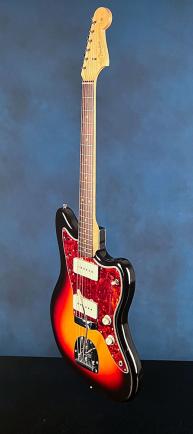A Near Mint Mid-1963 Pre-CBS Jazzmaster
1963 Fender Jazzmaster
This near mint++, all original three-tone pre-CBS Sunburst Jazzmaster weighs just 7.80 lbs. Solid alder, three-tone sunburst contoured body. One-piece maple neck with a nut width of just over 1 5/8 inches, a nice medium-to-thick profile and a scale length of 25 1/2 inches. Veneer Brazilian rosewood fretboard with 21 original thin frets and inlaid clay dot position markers. Headstock with 'Spaghetti' logo with "Fender" in gold with black trim, "Jazzmaster" and "Offset Contour Body Pat. Pending" in black, and "With Synchronized Floating Tremolo" in black below. Single "butterfly" string tree with 'long' metal spacer. Individual single-line Kluson Deluxe tuners with oval metal buttons (stamped "D-169400/PATENT NO." on the underside). Four-bolt neckplate with serial number "L06884" engraved between the top two screws. Two Jazzmaster pickups (large white rectangular six-polepiece pickups) with outputs of 7.78k and 7.50k. Four-layer (tortoiseshell over white and black) celluloid pickguard wth thirteen screws and aluminum grounding guard beneath. Two controls (master volume, master tone) with white plastic knobs, plus three-way selector switch on treble-horn and jack socket on the treble side of the pickguard. Second (rhythm) circuit on bass-side with two roller knobs (volume, tone) plus two-way slide.The potentiometers are stamped "3046320" (Stackpole May 1963) and "137XXX " (CTSXXX) the last three numbers obscured by solder). There does not appear to be any date-stamp on the end of the neck. Inside the bridge pickup cavity - written in pencil is the body date "6/20/63". There is also a "B" written in pencil on the body between the two pickups. Jazzmaster bridge with six individual adjustable threaded saddles and integrated tailpiece and tremolo.
Now lets be super critical about the condition of this so near to mint sixty-year old Jazzmaster. There is virtually no playing wear to the original thin frets and just one tiny and very shallow divot in the fretboard beneath the 'A' string at the second fret (the original owner must have liked playing the 'E' cord). There are three tiny indentations on the top - one near the jack input and the other two on the bass-side between the bridge and tremolo unit (nothing through the finish). There is one tiny indentation by the contour on the bass side (again nothing through the finish). There are three small marks on the edge of the treble horn, three small marks on the treble edge between the tone control and the jack input, and two very small marks on the lower edge near the strap button - all of which have been professionally 'touched-up' in black (the largest of these marks measures 1/4 x 1/8 inch). Other than the aforementioned remarks this is a near mint++ and totally original example - in fact this is the first time in its sixty-year life that it has been taken apart - it is most certainly one of the best we've ever seen! Complete with the original tremolo arm, bridge cover, black leather guitar strap and original 12-page Fender Jazzmaster hang-tag / instruction manual. Also included is a reprint of the 8-page Fender Catalog of 1963-1964. Housed in the original Fender brown Tolex case with tan leather ends and burnt orange plush lining (9.25)
Although unusual we have seen other examples of 1963 Fender Jazzmaster's (and Jaguars) without a neck date - production sixty years ago was not exactly a 'fine science' - there was occasionally human error!
"The Jazzmaster first appeared in Fender sales material during 1958, and at some $50 more than the Strat it became the new top-of-the-line model...Immediately striking to the electric guitarist of 1958 was the Jazzmaster's unusual offset-waist body shape...For the first time on a Fender, the Jazzmaster featured a separate rosewood fingerboard glued to the customary maple neck...The Jazzmaster's floating vibrato system was new, too, and had a tricky 'lock-off' facility aimed at preventing tuning problems if a string should break. The controls were certainly elaborate for the time…A small slide-switch selected between two individual circuits, offering player-preset rhythm and lead sounds. The idea was a good one: the ability to set up a rhythm sound and a lead sound, and switch between them. But the system seemed over-complicated to players brought up on straightforward volume and tone controls. The sound of the Jazzmaster was richer and warmer than players were used to from Fender. The name Jazzmaster had not been chosen at random, for Fender was aiming this different tone at jazz players, who at the time largely preferred hollowbody electrics, and principally those by Gibson. However, jazz guitarists found little appeal in this new, rather difficult solidbody guitar -- and mainstream Fender players largely stayed with their Stratocasters and Telecasters" (Tony Bacon, 50 Years of Fender, p. 26). Much to Fender's surprise, however, the Jazzmaster turned into the best surf guitar ever conceived.


















